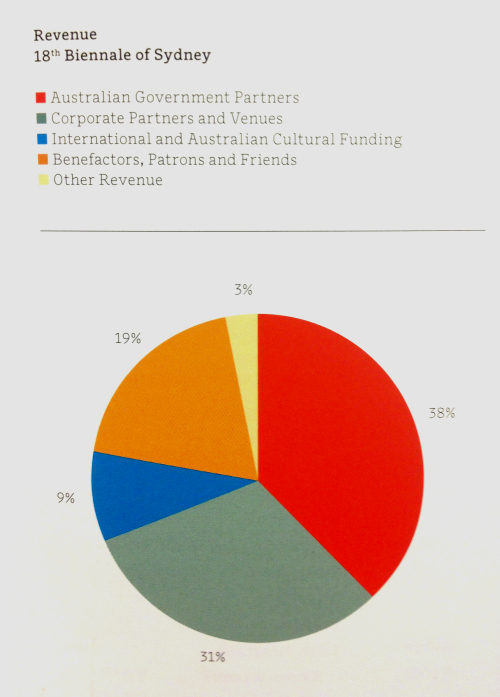Cai Guo-Qiang, Inopportune: Stage One, 2004. Installation view of the 17th Biennale of Sydney (2010) at Cockatoo Island. Photograph: Sebastian Kriete, Biennale of Sydney
Federal Arts Minister George Brandis has issued an indirect threat against ongoing funding for the Biennale of Sydney and other arts funding recipients that reject private sponsorship because of political pressure.
The statement is clearly targeted at the Biennale, which last week split with its founding sponsor Transfield Holdings, after boycotts and protests by artists because Transfield Holdings in a major shareholder in Transfield Services, which manages asylum seeker detention centres.
In a letter sent to Australia Council for the Arts Chairman, Rupert Myer, Brandis has asked that a policy be formulated to prevent arts organisations knocking back funding for political reasons. ”If the Sydney Biennale doesn’t need Transfield’s money, why should they be asking for ours?’ he said in the letter, the full text of which is available on ArtsHub.
In the letter, the Minister gave the Council no choice adding that if the Australia Council does not formulate such a policy, he would make a direction under s.12(1) (a) of the Australia Council Act.
‘One of the issues in developing such a policy will be to consider who should be the authority that determines whether or not the behaviour is reasonable or unreasonable. Now I don’t, frankly, have a fixed or dogmatic view about whether it should be the Australia Council or whether it should be the Minister or whether it should be some third-party arbiter. That is something that I’d welcome the views of the Australia Council about’, added Brandis.
The Australia Council’s response was brief: ‘The Chair of the Australia Council has received a letter from the Attorney and will be responding directly to him.’
In a statement the Australia Council confirmed The Biennale of Sydney is Key Organisation which has a four-year funding agreement from 2012 to 2015 based on peer review, and has committed $747,670 in 2014 under this agreement. The Australia Council has also provided $503,000 to the Biennale to support the 2014 event, including artists fees.
Through this Project Funding three of the boycotting artists have been funded – Charlie Sofo, Gabrielle de Vietri and Nathan Gray.
Brandis writes that the Biennale has a three-year Commonwealth funding arrangement via the Australia Council and that there is ‘no doubt when a renewal beyond 2015 arises for considered, the Australia Council will have regard to this episode and to the damage the board of the Sydney Biennale has done’.
The Minister’s intervention is particularly striking because last year in Opposition he led the Senate committee which successfully recommended changes to the new Australia Council Act enshrining freedom of expression. The pressure for those changes came from the Artspeak, with co-convenor Tamara Winkoff arguing, ‘It’s very important that the Australia Council acts as a voice for freedom of expression that is the hallmark of liberal democratic societies ensuring even forms of expression that are edgy and challenge ring are given a platform to stimulate us and to think about to prevent the hegemonic ideas that would otherwise tend to conservatism.’
Despite its earlier statement that ‘without our Founding Partner, the Biennale will no longer exist’, the Biennale could survive without Transfield. It is very unlikely to do so without the Australia Council.
The Biennale of Sydney is a robust organisation with multiple sources of funding. Over its forty-year history it has pulled through several funding shortfalls and the withdrawal of an estimated $600,000 that comes from Transfield interests – while a significant figure – was unlikely to topple the organisation.
Transfield Holdings is estimated to account for only about six per cent of the Biennale’s $10 million 2014 budget. Given that Transfield Holdings is only a shareholder in Transfield Services, which runs the detention centres, the proportion of funding that can be connected to the detention centres was at most two per cent.
In the past the organisation was more reliant on the Transfield dollar, but one only has to look at the reel of supporter’s logos on its website, not to mention personal giving, to recognise that the Biennale is more complex financial beast that even ten years ago.
The Biennale exhibition budget changes every two-year as a different curator with different projects has different demands, but the event has four primary Partners – Government bodies that top their funding list above Transfield: The Australian Government, The Australia Council for the Arts, Arts NSW through the NSW Government: Trade Industry and Arts portfolio, and the City of Sydney, a large portion of which is rolling multi-year funding that ensures the Biennale’s longevity outside corporate sponsorship.
For the 18th Biennale in 2012 Australian government funding partners provide 40% of revenue and there were an increased number of corporate sponsors providing a total of 23% of revenue.

From 18th Biennale of Sydney 2012 Report
ArtsHub has been in contact with each of the Biennale of Sydney’s primary Partners to ascertain their future commitment. In short the City of Sydney is in, Arts NSW wants to see the event continue but the Federal Government through Minister Brandis is looking to punish the Biennale, and the Australia Council is facing political pressure to follow suit.
Lord Mayor Clover Moore – no friend of the Abbot Government – told ArtsHub: ‘The City has a long involvement with the Biennale and has been a major supporter since 1988.’ Moore confirmed that, ‘The City is supporting this year’s Biennale with $1.15M in cash and value-in-kind activities. We have also committed up to $300,000 every two years to commission a major artwork at each of the next three Biennale of Sydney exhibitions. This artwork will remain in Sydney as a permanent legacy and become part of the City Art collection.’
With $600,000 still on the table for future Biennales, the City holds firm is sense of value in the relationship. Moore said, ‘The City is in dialogue with the Federal and State Governments, the Biennale Board and CEO to ensure the Biennale continues its international success.’
Moore’s Council is sympathetic to the artists’ boycott and she added, ‘At the request of the Council, I have written to the Prime Minister and Minister for Immigration and Border Protection to request that the Australian Government honour Australia’s international human rights obligations with regard to the treatment of asylum seekers. The Council’s view is that this situation has arisen as a result of the current and former Federal Government’s policy towards the treatment of asylum seekers.’
The NSW Government is supporting the 19th Biennale of Sydney through Arts NSW and its tourism and major events agency, Destination NSW. A statement from Minister George Souris’s office on 30 October confirmed, ‘The NSW Government will invest more than $1.4 million to support the 19th Biennale of Sydney’, and the support was ‘part of the Government’s commitment to ensure NSW remains the creative capital of Australia.’
But now this issue has hit the table will Souris’ office commitment be ongoing? Minister Souris has been a champion of cultural tourism and its success but his statement to ArtsHub today stopped short of reaffirming a commitment beyond the 2014 exhibition.
‘Arts NSW and the Australia Council will be working with the Biennale to ensure it continues to be a vital part of NSW’s cultural landscape,’ a spokesman told ArtsHub today, adding that as well as its funding the Biennale receives an accommodation subsidy as a tenant of Arts NSW and indemnity assistance under the NSW Exhibition Indemnification Scheme. The event takes place in venues across Sydney including the NSW Government supported institutions, AGNSW, MCA, Artspace and Carriageworks.
The Art NSW 2013-2014 Financial Year Report lists the Biennale among its funding recipients, a figure of $679,446 for year 3 of a quadrennial program (2012-2015). That means the roll-out will face review before the next exhibition in 2016.
Arts NSW was certainly happy to tout the cultural tourism advantages of the last Biennale. ‘There were more than 665,000 visits across all venues to the 18th Biennale in 2012 and almost 170,000 people visited the Biennale from outside Sydney.
‘The Deloitte Access Economics report on the Biennale estimated that the three-month event in 2012 contributed about $56 million to the NSW economy. These figures emphasise the value of arts and cultural events to the State. The Biennale of Sydney also plays a vital role in stimulating artistic and creative endeavor…’
Brandis’ letter will have far reaching applications for other arts organisations considering potential sponsors. While the practical question of what happens next hangs in the air, the moral question of whether boycotting artists did the right thing in withdrawing their art and placing pressure on the Biennale because of its association with Transfield, continues to occupy many minds. The broader question of whether sponsorship money always has a taint and whether artists are guilty of ‘vicious ingratitude’ as Communications Minister Malcolm Turnbull claimed this week, is addressed on ArtsHub this week by columnist Ben Eltham.
In all this, it’s easy to forget that we are only a week away from a Biennale that will showcase 200 important artists, with the oddly appropriate theme, Imagine what you desire, it is the artwork and the events that occupy the minds of those most engaged with the Biennale.




